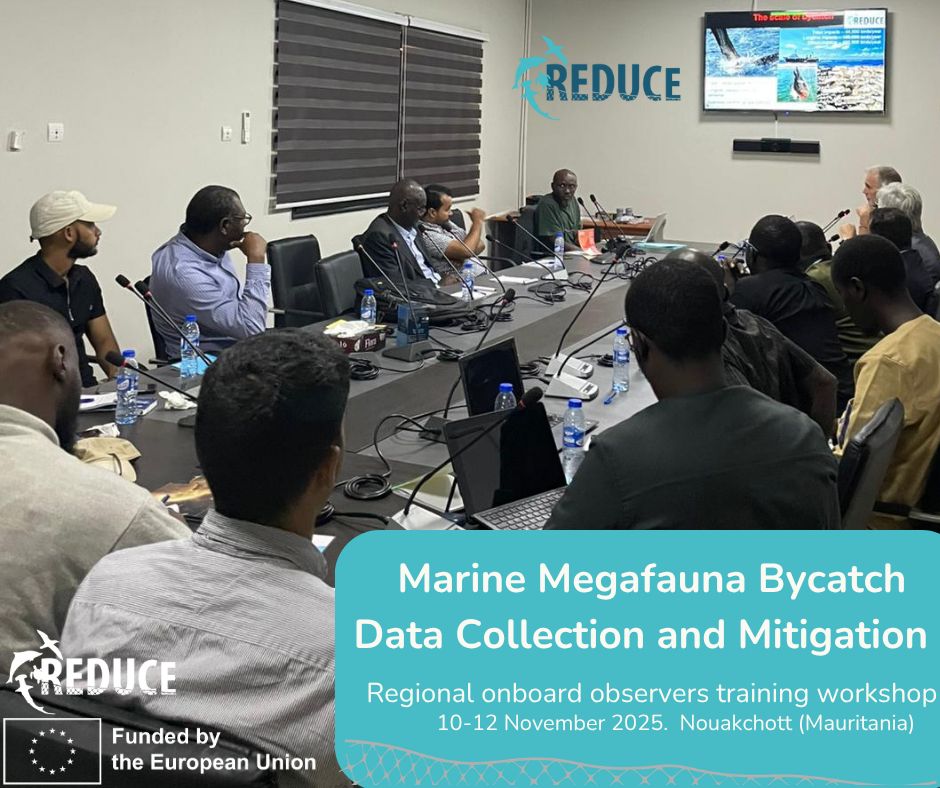
 10.11.2025 18:43 — 👍 1 🔁 1 💬 0 📌 0
10.11.2025 18:43 — 👍 1 🔁 1 💬 0 📌 0
@manelgazo.bsky.social
love mermaids | Large Marine Vertebrates 🦭🦈🐋Researcher - Professor at @ub.edu | Se coses de mar i de bitxos marins ~in mari multa latent~ #MarineEcology #ScienceForConservation

 10.11.2025 18:43 — 👍 1 🔁 1 💬 0 📌 0
10.11.2025 18:43 — 👍 1 🔁 1 💬 0 📌 0

The first day of the #REDUCE #RegionalOnboardObserversWorkshop "Training for Marine Megafauna Bycatch Data Collection and Mitigation" has come to an end. Participants have acquired updated knowledge on bycatch of Sea turtles and Seabirds. #bycatch #ETPmarinemegafauna #ETPBycatchReduction
10.11.2025 18:43 — 👍 1 🔁 1 💬 1 📌 0
Our second-day sessions of the #REDUCE #RegionalOnboardObserversWorkshop "Training for Marine Megafauna Bycatch Data Collection and Mitigation" are focused on bycatch of elasmobranchs (sharks and rays) and marine mammals.
#bycatch #ETPmarinemegafauna #ETPBycatchReduction

Presentations evolve around biology, ecology and species identification of these taxa. Attendees are also dealing with interactions with fisheries, mitigation techniques and best practices for safe handling & release of bycatch specimens (sea turtles, seabirds, sharks & rays and marine mammals).
11.11.2025 13:33 — 👍 2 🔁 2 💬 0 📌 0També tinc una entrevista de feina amb novio eh..eh :)
22.10.2025 07:26 — 👍 3 🔁 0 💬 2 📌 0:) ‘el ser humano es maravilloso’
Déu-n’hi-do
Follow @reduce-project.bsky.social to check news and progress of these last three days of Annual Meeting 2025.
05.09.2025 19:05 — 👍 2 🔁 0 💬 0 📌 0#ArticleIRBio
Autor @manelgazo.bsky.social @marinemegafauna.bsky.social

We’ve recently finished our #Bocadolça project, the main aim of which was to determine presence and seasonality of the bluntnose sixgill shark (Hexanchus griseus) in the deep waters off Catalonia (NW Mediterranean). @manelgazo.bsky.social (1/3)
25.07.2025 19:34 — 👍 6 🔁 2 💬 1 📌 0Our new research paper is out. We found microplastic ingestion by the blackmouth catshark (Galeus melastomus) in the canyoned continental margins of the Gulf of Lion was high, more than in other parts of the Mediterranean and was influenced by the role of those canyoned margins. Full thread 👇🏻🦈
04.08.2025 14:19 — 👍 7 🔁 2 💬 0 📌 0
you can find the study in this link▶️: www.sciencedirect.com/science/arti...
a work conducted with #MiquelCanals, #NuriaGonzáles @ignasinr14.bsky.social @odeigg.bsky.social @marinemegafauna.bsky.social
@ub.edu - @irbio-ub.bsky.social - @biologiaub.bsky.social - @cienciesterraub.bsky.social
✳️Galeus melastomus could act as a sentinel species for deep-sea microplastic exposure #MSFD
Our study shows the urgent need for pollution strategies that consider not just sources, but geomorphology and oceanographic processes that shape how pollution accumulates.

🌊 Because canyoned continental margins like those in the Gulf of Lion trap microplastics.
Submarine canyons, storms, river runoff and dense shelf water cascading funnel plastic particles down to the seafloor… right where these sharks live and feed.


📊 Over 80% of the specimens had ingested microplastics — mostly PET and cellophane fibres, the kind found in countless everyday products.
Even more than in sharks from other Mediterranean areas like the Tyrrhenian, Ligurian or Balearic seas. Why?


🦈 Sharks deep-dining... with a side of plastic
Yes. We’ve just published a new study in @elsevierconnect.bsky.social- MER showing the presence of microplastics in the digestive tract of the blackmouth catshark (Galeus melastomus), a deep-living species from the Gulf of Lion (NW Mediterranean).

You can call it a scavenger of the deep... but the circles at the corners of its mouth tell another story....🦑
#Hexanchus_griseus
#Bocadolça
#Shark

🔵🔵 Nova publicació sobre aquelles espècies comunes a casa nostra, però de difícil observació, el que no significa que no siguin també afectades per impactes antropogènics
@marinemegafauna.bsky.social @irbio-ub.bsky.social @biologiaub.bsky.social @craiubbiologia.bsky.social
@odeigg.bsky.social

Our study suggests dynamic protection zones for surface species & static closures for deep divers like beaked whales. Tailored conservation for diverse marine life.
#SustainableSeas #OceanPolicy



🌱 Distribution of species like striped dolphins & loggerhead turtles is driven by chlorophyll & current patterns, highlighting their link to surface ocean productivity.
#BluePlanet #EcosystemScience


🐋 Though outnumbered, sperm whales and fin whales dominate the community biomass in this marine protected area. Size matters in the deep!
#MegaFauna #MarineLife


🐬 7 cetacean & 2 sea turtle species spotted in the Mediterranean Cetacean Migration Corridor during 2023 surveys — vital biodiversity hotspot revealed! 🌊
#MarineConservation #Mediterranean
hem publicat els resultats dels vols a zona del Corredor de Migració de cetacis..quines espècies hi ha, on son i que fa que siguin allí.
més info @marinemegafauna.bsky.social 👇o a l'enllaç 👉 www.frontiersin.org/journals/mar...
(balenes amb gep? no en vam albirar, però #Fontiers ho edita aixi :) 🐋)

No he trobat cap notícia sobre el tauró #pelegrí de #PortDeLSelva que parli de:
- La mort d'una femella adulta.
- D'una espècie protegida.
- S’hauria d'abordar la temàtica de la captura 'accidental'?
Només s'ha transmès el missatge senzill: “era molt gros, no menja nens i nenes."
Gràcies! per tant allò que han votat a favor d’una esmena i s’han abstingut d’altres básicament vol dir que NO han votat en contra de matar llops. Deu ni do @juntsxcat.bsky.social
21.03.2025 07:10 — 👍 1 🔁 0 💬 0 📌 0Bon vespre. Algú em pot explicar com ha quedar el tema de la desprotecció del #llop ? És cert que @juntsxcat.bsky.social s’ha afegit a la iniciativa? Gràcies
20.03.2025 20:52 — 👍 0 🔁 0 💬 1 📌 0📢Reclamem a @juntsxcat.bsky.social i la resta de partits, que NO votin a favor d’aquesta esmena del PP.
🐺El llop és una espècie clau per a l’equilibri dels ecosistemes.

🚨Encara més, la proposta està plantejada des del total negacionisme científic. La caça del llop s’ha demostrat com una tècnica que té efectes nuls o, fins i tot, contraris als desitjats, en el control de la depredació.
www.eldiario.es/sociedad/caz...